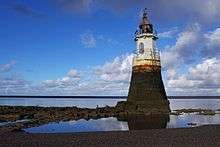Plover Scar Lighthouse
 The lighthouse at low tide in 2013 | |
 City of Lancaster | |
| Location | River Lune Estuary, Lancashire, England |
|---|---|
| Coordinates | 53°58′53″N 2°52′57″W / 53.981512°N 2.882594°WCoordinates: 53°58′53″N 2°52′57″W / 53.981512°N 2.882594°W |
| Year first constructed | 1847 |
| Automated | 1951 |
| Construction | stone tower |
| Tower shape | octagonal tower with balcony and lantern |
| Markings / pattern | white tower, black lantern |
| Height | 8 metres (26 ft) |
| Focal height | 6 metres (20 ft) |
| Characteristic | Fl W 2s. |
| Admiralty number | A4876 |
| NGA number | 114-5144 |
| ARLHS number | ENG-315 |
| Managing agent | Lancaster Port Commission |
Plover Scar Lighthouse also known as the Abbey Lighthouse is an active 19th century lighthouse sited at the entrance of the Lune estuary, near Cockersand Abbey in Lancashire, England.[1] It was built in 1847, as the lower light of a pair of leading lights, and is therefore also called the front or Low Light. The rear or High light, known as Cockersand Lighthouse once stood next to the Abbey Lighthouse cottage on Slack Lane was originally a wooden tower, later replaced by a metal framework beacon.[2] The leading lights helped ships navigate into the Lune estuary, to reach Glasson Dock and then onwards via the Lancaster Canal to the port of Lancaster, with Plover Scar marking the rocky outcrop at the edge of the deep water channel into the estuary.[1] On the 5th March 2016 the lighthouse was struck by a commercial vessel and is currently undergoing a brick by brick restoration by contractors MPM North West. The tower crane erected at the site is the same one used for the refurbishment of Blackpool Tower.
Description
The lighthouse consists of a 8-metre-high (26 ft) white conical stone tower, with a black lantern and twin galleries, built on a rock ledge that is uncovered at low tide. With a focal height of 6m above sea level, the light can be seen for 6 nautical miles. Its light characteristic is made up of a flash of white light every two seconds.[3] The lighthouse is maintained by the Lancaster Port Commission, and is registered under the international Admiralty number A4876 and has the NGA identifier of 114-5144.[1][3]
Keepers
Prior to automation the lighthouse keepers and their families lived in the lighthouse cottage next to the Cockersand lighthouse. Originally the accommodation was incorporated into the base of the lighthouse structure, but was later replaced by the cottage that still stands today. The keepers maintained both lighthouses, walking across to Plover Scar at low tide. The Raby family kept the lights for nearly a century, until 1945 when it was taken over by the Parkinson family. Mrs Parkinson was filmed maintaining the lights in 1948 by the British Pathé news organisation.[2][4]
See also
References
- 1 2 3 Rowlett, Russ. "Lighthouses of Northwest England". The Lighthouse Directory. University of North Carolina at Chapel Hill. Retrieved 5 May 2016.
- 1 2 "Cockersand Lighthouse". Lighthouse Compendium. Retrieved 5 May 2016.
- 1 2 List of Lights, Pub. 114, British Isles, English Channel and North Sea (PDF). List of Lights. United States National Geospatial-Intelligence Agency. 2015. p. 75.
- ↑ "Lighthouse 1948". Britishpathe.com. Retrieved 5 May 2016.
External links
| Wikimedia Commons has media related to Plover Scar Lighthouse. |